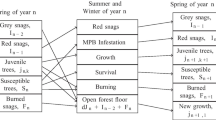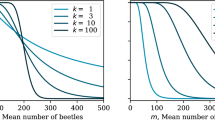Summary
A simple two-species differential equation model is used to investigate the intrinsic metastability of forest ecosystems subjected to bark beetle infestations. We demonstrate that only one globally stable node or limit cycle is likely under biologically plausible conditions, but that, in the former case, this equilibrium is very sensitive to external perturbation.
Similar content being viewed by others
References
Amman, G. D. andB. H. Baker (1972) Mountian pine beetle influence on lodgepole pine stand structure.J. Forestry 70: 204–209.
Anderson, R. M. andR. M. May (1981) The population dynamics of microparasites and their invertebrate hosts.Phil. Trans. Royal Soc. London (B)291: 451–524.
Bakke, A., O. Austara andH. Petterson (1977) Seasonal flight activity and attack pattern ofIps typographus in Norway under epidemic conditions.Norsk Inst. Skogjorsk. 33: 255–268.
Berryman, A. A. (1972) Resistance of conifers to invasion by bark beetle-fungus associations.BioSci. 22: 598–602.
Berryman, A. A. (1982a) Population dynamics of bark beetles. InJ. B. Mitton andK. B. Sturgeon (eds) Bark beetles in North American conifers—a system for the study of evolutionary biology. Univ. Texas Press, Austin.
Berryman, A. A. (1982b) Biological control, thresholds, and pest outbreaks.Environ. Entomol. 11: 544–549.
Berryman, A. A. (1984) Threshold theory and its application to pest population management. InG. R. Conway (ed) Pest and pathogen control—strategy, tactics and policy models. Wiley-IIASA, Wiley Intersciences Publ., Chichester (in press).
Borden, J. H. (1982) Aggregation pheromones. InJ. B. Mitton andK. B. Sturgeon (eds) Bark beetles in North American conifers—a system for the study of evolutionary biology. Univ. Texas Press, Austin.
Cates, R. G. andH. Alexander (1982) Host resistance and susceptibility. InJ. B. Mitton andK. B. Sturgeon (eds) Bark beetles in North American confiners—a system for the study of evolutionary biology. Univ. Texas Press, Austin.
Hanover, J. W. (1975) Physiology of tree resistance to insects.Ann. Rev. Entomol. 20: 75–95.
Holling, C. S., D. D. Jones andW. C. Clark (1977) Ecological policy design—A case study of forest and pest management. InG. A. Norton andC. S. Holling (eds)Proceedings of a Conference on Pest Management. Int. Inst. Appl. Syst. Anal., Laxenburg, Austria.
Isaev, A. S. andR. G. Khlebopros (1977) Intertial and noninertial factors regulating forest insect population density. InG. A. Norton andC. S. Holling (eds)Proceedings of a Conference on Pest Management. Int., Inst. Appl. Syst. Anal., Laxenburg, Austria.
Leslie, P. H. (1948) Some further notes on the use of matrices in population mathematics.Biometrica 35: 213–245.
Lotka, A. J. (1956)Elements of mathematical biology (republication ofElements of physical biology, first published in 1924), Dover, New York.
Ludwig, D., D. D. Jones andC. S. Holling (1978) Qualitative analysis of insect outbreak systems: The spruce budworm and forest.J. Anim. Ecol. 47: 315–332.
May, R. M. (1975)Stability and complexity of model ecosystems (second edition), Princeton University, Princeton.
Noy-Meir, I. (1975) Stability of grazing systems: An application of predator-prey graphs.J. Ecol. 63: 459–481.
Raffa, K. F. andA. A. Berryman (1983) The role of host plant resistance in the colonization behavior and ecology of bark beetles (Coleoptera: Scolytidae).Ecol. Monogr. 53: 27–49.
Rosenzweig, M. L. andR. H. Macarthur (1963) Graphic representation and stability conditions of predator-prey interactions.Amer. Nat. 97: 209–223.
Thalenhorst, W. (1958) Grundzuge der populationsdynamik des grossen FitchenborkenkafersIps typographus L.Shrift. Forstl. Fakul. Univ. Gottingen 21.
Wollkind, D. J., J. A. Logan andA. A. Berryman (1978) Asymptotic methods for modeling biological processes.Res. Pop. Ecol. 20: 79–90.
Wollkind, D. J., A. Hastings andJ. A. Logan (1980) Functional response, numerical response, and stability in arthropod predator-prey ecosystems involving age-structure.Res. Pop. Ecol. 22: 323–338.
Author information
Authors and Affiliations
Rights and permissions
About this article
Cite this article
Berryman, A.A., Stenseth, N.C. & Wollkind, D.J. Metastability of forest ecosystems infested by bark beetles. Res Popul Ecol 26, 13–29 (1984). https://doi.org/10.1007/BF02515505
Issue Date:
DOI: https://doi.org/10.1007/BF02515505




